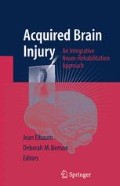Abstract
Rehabilitation nurses are licensed professionals (registered nurses) with additional training and experience in rehabilitation. Training typically consists of an orientation to the hospital followed by a didactic component related to care of the rehabilitation patient and a preceptorship of varying lengths dependent on previous experience. Rehabilitation nurses can become credentialed through certification in rehabilitation nursing through the Association of Rehabilitation Nurses (ARN) or further credentialed in neuro rehabilitation nursing by obtaining certification in Neuroscience Nursing through the American Association of Neuroscience Nurses (AANN). Appendix 1 lists a number of professional associations of interest to the rehabilitation nurse. Clinical judgment, skills and an evidence-based approach to practice must be maintained through continuing education, training, and the ongoing evaluation of neuro-specific competencies to validate proficiency of care of the neuro rehabilitation patient. These are continuous processes that must be sought by nurses to maintain expertise in the rapidly advancing fields of neuroscience and neurorehabilitation. Professional associations, like the ARN and AANN, provide professional development through education, advocacy, collaboration and research within the specialty (Doble et al., 2000).
Access this chapter
Tax calculation will be finalised at checkout
Purchases are for personal use only
Preview
Unable to display preview. Download preview PDF.
References
Barker, E. (2002) Neuroscience Nursing: A Spectrum of Care, 2nd ed. St. Louis, Missouri: Mosby (Original work published 1994).
Barnes, M. (2003) Principles of neurological rehabilitation. Journal of Neurology, Neurosurgery, and Psychiatry 74:3–7.
Brown, S. (2004) The braden scale: A review of the research evidence. Orthopedic Nursing 23(1):30–38.
Centers for Disease Control and Prevention. Web-based Injury Statistics Query and Reporting System (WISQARS) [Online]. (2005) National Center for Injury Prevention and Control, Centers for Disease Control and Prevention (producer). Retrieved June 18, 2006, from www.cdc.gov/ncipc/wisqars.
Chandler, B., Brown, S. (1998) Sex and relationship dysfunction in neurological disability. Journal of Neurology, Neuroscience, and Psychiatry 65:877–880.
Corrigan, B., Allen, K., Moore, J. et al. (1999) Preventing falls in acute care. In Abraham, I., Bottrell, M., Fulmer, T., & Mezey, M. (eds.): Geriatric Nursing Protocols for Best Practice. New York: Springer Publishing Company, Inc., pp. 77–99.
Doble, Rosemary K., Curley, Martha A.Q., Hession-Laband, Eileen. Marino, Barbara L., Shaw, Susan M. (2000). Using the synergy model to link nursing care to diagnosis-related groups. Critical Care Nurse 20(3):XX–XX.
Edwards, P.A. (2000) The Specialty Practice of Rehabilitation Nursing: A Core Curriculum, 4th ed. Glenview, IL: Association of Rehabilitation Nurses.
Galloway, S.,Turner,L. (1999) Pain assessment in older adultswhoare cognitively impaired. Journal of Gerontological Nursing 25(7):34–39.
Hawley, C.A., Taylor, R., Hellawell, D.J., Pentland, B. (1999) Use of the functional assessment measure (FIM + FAM) in head injury rehabilitation: A psychometric analysis. Journal of Neurology, Neurosurgery, and Psychiatry 67:749–754.
Langhorne, P., Legg, L. (2003) Evidence behind stroke rehabilitation. Journal of Neurology, Neurosurgery, and Psychiatry 74:18–21.
Makelbust, J. Sieggreen, M. (2000) Pressure Ulcers: Guidelines for Prevention and Management, 3rd ed. Pennsylvania: Springhouse.
Pasero, C., Reed, B.A., McCaffery, M. (1999) Pain in the elderly. In McCaffery, M. & Pasero, C., (eds.): Pain: Clinical Manual for Nursing Practice, 2nd ed. St. Louis, MO: Mosby, pp. 674–710.
St. Marie, B. (2002) Core Curriculum for Pain Management Nursing. Philadelphia, Pennsylvania: WB Saunders.
Thorn, S., RGN, BSc, DipN. (2000) Neurological rehabilitation nursing: A review of the research. Journal of Advanced Nursing 31(5):1029–1038.
Editor information
Editors and Affiliations
Rights and permissions
Copyright information
© 2007 Springer
About this chapter
Cite this chapter
APRILE, A., REILLY, K. (2007). Nursing Care of the Neuro-Rehabilitation Patient. In: Elbaum, J., Benson, D.M. (eds) Acquired Brain Injury. Springer, New York, NY. https://doi.org/10.1007/978-0-387-37575-5_9
Download citation
DOI: https://doi.org/10.1007/978-0-387-37575-5_9
Publisher Name: Springer, New York, NY
Print ISBN: 978-0-387-37574-8
Online ISBN: 978-0-387-37575-5
eBook Packages: Behavioral ScienceBehavioral Science and Psychology (R0)

